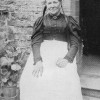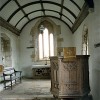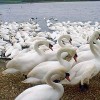This was a night when gale force winds lashed the Jurassic cliffs of Dorset’s coastline, a night when the sea thundered ashore on Dorset’s beaches, and a night when lifeboats saw action but still there were vessels lost and numerous casualties. Furthermore, this was a night when many seafarers sailed their last voyage. And it was a night when the decision to head for shelter or go bare masted into the storm would be critical – and a night when good Captains earned their rank.
Storms ushered in September of 1877 and for seafarers in the waters off the Dorset coast the nights of September 10th and 11th were very difficult. A French fishing vessel crashed aground on Chesil Beach, all hands lost. Many local Chesil fishing boats were smashed up on the beach. But the biggest loss came as two large vessels both at the start of long deep sea voyages out of London collided off Portland.
Ploughing down the Channel and in the charge of a pilot was the iron ship Avalanche, her Captain, E. Williams was well thought of by his ship’s owners, Shaw, Savill and Company. He was a seaman of great experience: he and his ship were much favoured by colonists who regularly visited or traded with England. The crew and officers numbered thirty four, to which could be added a steward and twelve foreign seamen along with emigrants and other passengers making a total of about one hundred souls on board the Avalanche, which was headed for New Zealand. Built three years earlier, the ship was rated A1 at Lloyds and was of some 1,000 tons.
The wooden ship Forest of Windsor bound for Sandy Hook near New York in ballast, had departed London at about the same time as the Avalanche. The ship, about 200 ft and nearly 1,500 tons, was built at Windsor, Nova Scotia in 1873; she was owned by Churchill and Sons and was also registered A1 at Lloyds. Her master was Captain Ephraim Lockheart.
On September 10th the wind backed, blowing strongly from the south-west causing huge seas in the Race off Portland. The following evening, with the tide under her, Avalanche sailed close in to Portland Bill in an attempt to steer clear of the tremendous seas churned up by the Race. Rain kept her from the view of the lighthouse-keepers and others watching the sea from the shore.
Captain Lockheart on the Forest of Windsor had been leading his hard stretched crew of just twenty-one men continuously through the turbulent seas encountered during the passage down the Channel. He caught only a glimpse of the cliffs off Portland through the rain. Both vessels hidden from each other by a wall of rain were racing through this turbulent vortex of water, their masters unknowingly heading directly towards each other.
At half-past nine on the evening of Tuesday, September 11th with no warning, the Forest of Windsor suddenly tore into Avalanche. The ship foundered and all her crew and passengers were lost to the sea within minutes with the exception of the Third Officer, John Sherrington, and two seamen who against all the odds stacked against them managed to get on board the Forest of Windsor. Two emigrant families with ten children between them were amongst those lost.
The Forest of Windsor began to fill with water but remained upright long enough for attempts to be made to launch her boats. Violent squalls of wind and high seas swamped four of the boats but one, manned by Captain Lockheart, his chief mate and John Sherrington from the Avalanche, and nine others was able to get away before the Forest of Windsor capsized.
Peculiar to the Portland area is a fishing boat known as a lerret. Not only is it a good sea boat but has some characteristics of a surf boat which enable it to land through the surf onto Chesil Beach. It was to their lerrets that early on Wednesday morning, several brave Portland fishermen ran. J. Chaddick, John and Tom Way, Tom Pearce, Tom and Lew White and John Flann to one boat and to another went another Flann, another John Way, G. White, Bennett, and J and G Byatt. Later the bravery of all these men was recognised by the Agent General of New Zealand, who sent them all a payment of £5 matching an award made to them by the Board of Trade. A further £130 was collected and handed to the men later in the year.
For several days bodies of the drowned washed ashore on to Chesil Beach and at Portland, Chickerwell and Abbotsbury. The Jury at the Coroner’s Inquest held at Portland on September 15th expressed dismay at the “neglect to provide decently for the interment of the drowned.”
The upturned hull of the Forest of Windsor showed no inclination to sink; it was a hazard to shipping and the Royal Navy ordered H.M.S. Defence under the command of Captain Howard, aided by H.M.S. Black Prince and H.M.S. Galatea to sink the wreck. The Navy attempted to blow the wreck out of the water using torpedoes but these just ran through the wreck. Over the following three weeks it shrugged off gunpowder charges, mines and all sorts of means, stubbornly remaining unmoved. As if to mock its attackers after one assult the lid of a seaman’s chest floated to the surface decorated with a picture of the Forest of Windsor in full sail. The demolition of the wreck was finally accomplished three and a half weeks after the collision at a cost of about £1,000.
There is an illustration of the rescue in the photo gallery.



